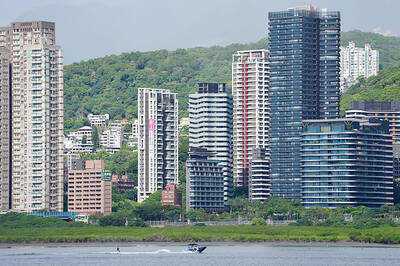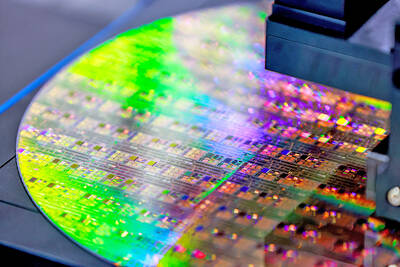Aerospace Industrial Development Corp (AIDC, 漢翔航空工業), the nation’s largest civilian and military aerospace manufacturer, is eyeing opportunities from rising demand for carbon fiber composite materials.
As aircraft design advances, carbon fiber composite is becoming a bigger part of the bill of materials, the company said at news conference in Taipei.
AIDC, which has partnered with US-based Bell Helicopter, said that carbon fiber composites now account for about 90 percent of the materials it uses, while the figure has climbed to about 50 percent for many civilian and military aircraft, AIDC president Lin Nan-chu (林南助) said.
PRODUCT SUBSTITUTES
Composites in mainstream jetliners, such as Boeing Co’s B787 and Airbus SE’s A350, have also surpassed 50 percent, replacing parts that were previously made with metal alloys, Lin said.
A similar trend has been in older product lines, such as the Boeing 737 and the Airbus A320 family, he said.
The demand for commercial aircraft has been rising at the same time, with Airbus gauging demand in the next 20 years at 34,900 units, worth an estimated US$5.3 trillion, and Boeing predicting the backlog to reach 41,030 units, worth about US$6.1 trillion, Lin said.
He said that suppliers are expected to focus resources on developing moldless composite manufacturing and further improvements to automation, while advanced aircraft designs would reduce reliance on fasteners.
Aerospace suppliers have been pursuing composite material technologies in face of rising competition that requires ever-increasing speed, flexibility and cost savings, AIDC chairman Anson Liao (廖榮鑫) said.
While composite materials are praised for their strength, lightness and corrosion resistance, the aerospace sector would have to develop recycling solutions to mitigate the materials’ environmental impact, Liao said.
The market for composite materials is expected to expand 5 percent annually, increasing from last year’s US$82 billion to US$103 billion by 2021, Liao said, citing findings by JEC Group, a France-based industry association.
BIOMIMICRY
Liao said that carbon composite manufacturing could use 3D printing technology to accommodate the complexity of future aircraft designs that rely on biomimicry.
Biomimicry refers to engineering that draws on insights from nature, such as studying birds to build quieter aircraft or mimicking the structure of bones and cells in aircraft bulkhead designs to reduce weight.
Meanwhile, UHT Unitech Co (永虹先進材料), a carbon-composite producer that is a member of AIDC’s “A-Team” supply chain alliance, said it expects to begin shipping products to fill an order by a Chinese customer in the first quarter of next year, thanks to its proprietary high-temperature graphitization manufacturing process.
Founded in 2012, UHT Unitech is a newcomer to the field, which is dominated by Japan’s Toray Industries Inc and Toho Tenax Co Ltd, and US-based Hexcel Corp.

Taiwan’s rapidly aging population is fueling a sharp increase in homes occupied solely by elderly people, a trend that is reshaping the nation’s housing market and social fabric, real-estate brokers said yesterday. About 850,000 residences were occupied by elderly people in the first quarter, including 655,000 that housed only one resident, the Ministry of the Interior said. The figures have nearly doubled from a decade earlier, Great Home Realty Co (大家房屋) said, as people aged 65 and older now make up 20.8 percent of the population. “The so-called silver tsunami represents more than just a demographic shift — it could fundamentally redefine the

The US government on Wednesday sanctioned more than two dozen companies in China, Turkey and the United Arab Emirates, including offshoots of a US chip firm, accusing the businesses of providing illicit support to Iran’s military or proxies. The US Department of Commerce included two subsidiaries of US-based chip distributor Arrow Electronics Inc (艾睿電子) on its so-called entity list published on the federal register for facilitating purchases by Iran’s proxies of US tech. Arrow spokesman John Hourigan said that the subsidiaries have been operating in full compliance with US export control regulations and his company is discussing with the US Bureau of

Businesses across the global semiconductor supply chain are bracing themselves for disruptions from an escalating trade war, after China imposed curbs on rare earth mineral exports and the US responded with additional tariffs and restrictions on software sales to the Asian nation. China’s restrictions, the most targeted move yet to limit supplies of rare earth materials, represent the first major attempt by Beijing to exercise long-arm jurisdiction over foreign companies to target the semiconductor industry, threatening to stall the chips powering the artificial intelligence (AI) boom. They prompted US President Donald Trump on Friday to announce that he would impose an additional

Pegatron Corp (和碩), a key assembler of Apple Inc’s iPhones, on Thursday reported a 12.3 percent year-on-year decline in revenue for last quarter to NT$257.86 billion (US$8.44 billion), but it expects revenue to improve in the second half on traditional holiday demand. The fourth quarter is usually the peak season for its communications products, a company official said on condition of anonymity. As Apple released its new iPhone 17 series early last month, sales in the communications segment rose sequentially last month, the official said. Shipments to Apple have been stable and in line with earlier expectations, they said. Pegatron shipped 2.4 million notebook